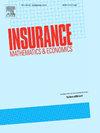Improving detections of serial dynamics for longitudinal actuarial data with underwriting-controlled testing
IF 2.2
2区 经济学
Q2 ECONOMICS
引用次数: 0
Abstract
Longitudinal actuarial data, where policyholders' claims are recorded over multiple years, offer valuable insights for pricing and reserving. However, standard modeling approaches typically assume no serial dynamics in conditional claim distributions over time. Such an assumption is difficult to validate given that most non-life insurance products are short-term, yielding data from only a few years. Recent diagnostic methods can detect serial dynamics but do not distinguish between changes induced by endogenous underwriting standards (e.g., renewal and pricing policies favoring low-risk policyholders) and genuine, exogenous temporal shifts (e.g., evolving socioeconomic environment). In this paper, we develop underwriting-controlled serial dynamic tests for longitudinal actuarial data. By applying an inverse-probability-weighted estimation approach, we adjust for underwriting effects and thus detect the true underlying serial dynamics. We propose tests based on three metrics, parameter difference, prediction bias, and prediction loss, enabling both statistical and economic interpretations of dynamic changes. Simulation studies show that our tests avoid false detections caused by underwriting effects. An analysis using European automobile insurance data illustrates how our approach offers deeper insights into when and why serial dynamics emerge.
利用承保控制测试改进纵向精算数据的连续动态检测
纵向精算数据记录了投保人多年来的索赔,为定价和保留提供了有价值的见解。然而,标准建模方法通常假设在有条件索赔分布中没有随时间的连续动态。鉴于大多数非寿险产品都是短期的,只产生几年的数据,这种假设很难得到验证。最近的诊断方法可以检测到一系列动态,但不能区分内生承保标准(例如,有利于低风险投保人的续保和定价政策)和真正的外生时间变化(例如,不断变化的社会经济环境)引起的变化。本文对纵向精算数据进行承保控制的连续动态检验。通过应用逆概率加权估计方法,我们调整承保效应,从而检测真正的潜在序列动态。我们提出了基于参数差异、预测偏差和预测损失这三个指标的测试,从而能够对动态变化进行统计和经济解释。模拟研究表明,我们的测试避免了由承保效应引起的错误检测。一项使用欧洲汽车保险数据的分析说明了我们的方法如何对序列动态何时以及为何出现提供了更深入的见解。
本文章由计算机程序翻译,如有差异,请以英文原文为准。
求助全文
约1分钟内获得全文
求助全文
来源期刊

Insurance Mathematics & Economics
管理科学-数学跨学科应用
CiteScore
3.40
自引率
15.80%
发文量
90
审稿时长
17.3 weeks
期刊介绍:
Insurance: Mathematics and Economics publishes leading research spanning all fields of actuarial science research. It appears six times per year and is the largest journal in actuarial science research around the world.
Insurance: Mathematics and Economics is an international academic journal that aims to strengthen the communication between individuals and groups who develop and apply research results in actuarial science. The journal feels a particular obligation to facilitate closer cooperation between those who conduct research in insurance mathematics and quantitative insurance economics, and practicing actuaries who are interested in the implementation of the results. To this purpose, Insurance: Mathematics and Economics publishes high-quality articles of broad international interest, concerned with either the theory of insurance mathematics and quantitative insurance economics or the inventive application of it, including empirical or experimental results. Articles that combine several of these aspects are particularly considered.
 求助内容:
求助内容: 应助结果提醒方式:
应助结果提醒方式:


